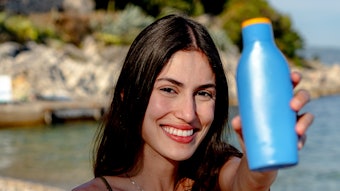
Read the full article in the September 2021 digital edition. . .
Cosmetics and personal care, as part of the fast-moving consumer goods (FMCG) industry, thrive on innovation and trends. Innovation trends may be based on technologies, e.g., a new method of emulsification, novel active delivery system, etc., or consumer conceptions and social movements.
Many industry trends stem from consumer movements. A good example is the demand for natural cosmetics, meaning those based on naturally derived ingredients, as initially these were perceived to be safer. This started around 1960 but has changed more recently to clean or green beauty, for which definitions vary.
One behavioral study1 based on Google trends analyzed U.S. data across a span of 189 months from 2004 to 2019. This revealed a direct correlation between searches for clean and green beauty; it also suggested a driver for this trend is growing consumer concern over cosmetic ingredients—particularly endocrine disruptors.
This article outlines how regulators in the EU and UK have put measures into place to assure consumers of product safety, particularly relating to endocrine disruptors. It also considers how these measures, including the Cosmetic Product Safety Report (CPSR), can provide formulators guidance on creating safer, "healthier" products. Finally, it proposes using the CPSR to communicate to consumers the extent to which products are tested to shift the parlance from "clean" to "safe."
Endocrine Disruptors and EU/UK Regulations
Endocrine disruptors are both natural or man-made chemical substances that can act upon the endocrine systems of humans and animals. Exposure to endocrine disruptors can occur from any number of sources, such as foods with residual pesticides, or toys or consumer products such as cosmetics that include substances like Bisphenol A (BPA), phthalates and flame retardants.
In order to ensure the protection of human health, in the EU Cosmetic Regulation 1223, 2009 and its UK counterpart, Regulation 2009/1223 and the Cosmetic Products Enforcement Regulations 2013, there are restrictions for using certain substances in cosmetic products.2, 3 Applications of ingredients that may cause certain risks to human health are prohibited (Annex II) or restricted (Annex III). The ingredients in the annexes can be amended by the EU commission based on technical and scientific progress. Meanwhile, chemical ingredients with probable adverse effect to environment, day-to-day life and industrial process are regulated under REACH (The Registration, Evaluation, Authorization and Restriction of Chemicals) which came to place into force on June 1, 2007.
The cosmetic regulation may not have a specific clause for endocrine disruptors, but when a substance is identified as a potential endocrine disruptor, it is also considered as a CMR (Carcinogenic, Mutagenic or toxic for Reproduction). Based on Article 15 of the EU regulation for finished cosmetic products, the use of an ingredient classified as CMR, under Regulation EU 1272/2008, is prohibited.4 The derogation for Article 15 is laid down in Article 15 (1) and 15 (2). The use of CMR substances is only permitted when a substance is evaluated by the Scientific Committee on Consumer Safety (SCCS), follows food safety requirements of the General Food Law and lacks suitable alternative substances.5
The SCCS approach to the safety assessment of endocrine disruptors is defined in SCCS/1544/14. In this memorandum, the SCCS follows the European Food Safety Authority (EFSA) and Endocrine disruptors Expert Advisory Group. The main principle of this assessment is to evaluate endocrine disruptors based on risk assessment and not only hazard identification. As such, the level of concern for endocrine disruptors is not determined exclusively by risk assessment but also by protection goals set by risk management.
Based on the SCCS methodology, to evaluate potential risk for human health, safety exposure to CMRs in specific vulnerable groups such as children and pregnant women also must be taken into consideration. This is an important point since everyday cosmetic products are used daily by all different members of society.6 As outcomes of using this methodology, we can refer to some of the recent SCCS opinions on potential endocrine disruptors such as parabens,7-10 triclosan,11, 12 homosalate,13 benzophenones,12, 14 resorcinol15 and cyclomethicone.16 Based on the SCCS evaluation of substances, and if the committee concludes the risk of a potential endocrine disruptor to human health, the EU Commission would be in a position to restrict or ban the ingredient. A good example of this case-by-case assessment by the SCCS is parabens. The SCCS carried out safety assessments for different types of parabens. While the committee approved the safety of certain types with specific limitations and usage concentrations, it could not rule out the risk of other categories of parabens for human health—e.g., isopropylparaben, isobutylparaben, phenylparaben and pentylparaben. Based on this assessment, the EU commission restricts or bans certain parabens that can have a risk potential for human health.
In addition to individual assessment of ingredients of concern by the SCCS, the EU and UK approach to regulation places a strong emphasis on the safety of finished cosmetic products. Based on Article 10 of cosmetic regulation,17 any finished cosmetic product, before being placed on the market, shall be evaluated by a qualified safety assessor. For the safety assessment of a finished cosmetic product, based on Annex I, EU Reg 1223, 2009 in addition to certain required tests like stability and microbiology, exposure to both finished cosmetic products and substances shall be calculated. Furthermore, based on the toxicological profiles of each substance used in the product and their relevant margin of safety, the assessor should provide compelling reasoning as to why the product can be considered safe when being placed on the market.2
The Clean Beauty Question
Considering the regular review of endocrine disruptors and substances of high concern under EU regulations, as well as attention to finished product’s safety, the question becomes why clean beauty is still a noticeable trend in the EU. Looking at the current market, cosmetic brands mainly use “clean beauty” to describe the fact that their products may not contain certain ingredients considered to be unsafe or controversial, such as parabens or endocrine disruptors. As a claim, this terminology does not yet have a defined regulatory framework and perhaps could be considered more of a buzzword than a real efficacy claim for a product. This raises another question: Are brands allowed to use this claim under the EU Reg 1223, 2009?
. . .Read more in the September 2021 digital edition. . .
References
- Beck, K. and Brink, T.L. (2019). Clean and green beauty movement: Does it reflect the growing concern of endocrine disruptors in cosmetics? SCCUR Fall 2019 event conference poster.
- Official Journal of the European Union (2009). Regulation (EC) 1223, 2009 of the European Parliament and of the Council. Available at: https://ec.europa.eu/health/sites/default/files/endocrine_disruptors/docs/cosmetic_1223_2009_regulation_en.pdf
- UK Office for Product Safety & Standards (2021, Jan 1). Regulation 2009/1223 and the Cosmetic Products Enforcement Regulations 2013. Available at https://assets.publishing.service.gov.uk/government/uploads/system/uploads/attachment_data/file/968602/Guide-to-cosmetic-products-regulations-2013-tp.pdf
- European Agency for Safety and Health at Work (2021, Mar 19). Regulation (EC) No. 1272/2008 - classification, labelling and packaging of substances and mixtures (CLP) of the European Parliament and of the Council of 16 December 2008. Available at: https://osha.europa.eu/en/legislation/directives/regulation-ec-no-1272-2008-classification-labelling-and-packaging-of-substances-and-mixtures
- Ibid Ref 2, Article 15
- European Commission (2018). Review of Regulation No. 1223, 2009 of the European Parliament and of the Council on cosmetic products with regards to substances with endocrine disrupting properties. Available at: https://eur-lex.europa.eu/legal-content/EN/TXT/PDF/?uri=CELEX:52018DC0739&rid=2
- SCCP (2006, Oct 10). Scientific Committee on Consumer Products (SCCP) Opinion on parabens. Available at: https://ec.europa.eu/health/ph_risk/committees/04_sccp/docs/sccp_o_074.pdf
- SCCP (2008, Jun 24). Scientific Committee on Consumer Products (SCCP) Opinion on parabens. Available at: https://ec.europa.eu/health/archive/ph_risk/committees/04_sccp/docs/sccp_o_138.pdf
- SCCS (2013, May 3). Scientific Committee on Consumer Safety (SCCS) Opinion on parabens. Available at: https://ec.europa.eu/health/scientific_committees/consumer_safety/docs/sccs_o_041.pdf
- SCCS (2011, Mar 22). Scientific Committee on Consumer Safety (SCCS) Opinion on parabens. Available at: https://ec.europa.eu/health/scientific_committees/consumer_safety/docs/sccs_o_132.pdf
- SCCP (2009, Jan 21). Scientific Committee on Consumer Products (SCCP) Opinion on triclosan. Available at: https://ec.europa.eu/health/ph_risk/committees/04_sccp/docs/sccp_o_166.pdf
- SCCS (2009, Jan 21). Scientific Committee on Consumer Safety (SCCS) Opinion on triclosan. Available at: https://ec.europa.eu/health/scientific_committees/consumer_safety/docs/sccs_o_054.pdf
- SCCP (2007, Mar 21). Scientific Committee on Consumer Products (SCCP) Opinion on homosalate. Available at: https://ec.europa.eu/health/ph_risk/committees/04_sccp/docs/sccp_o_097.pdf
- SCCS (2021, Mar 30-31). Scientific Committee on Consumer Safety opinion on Benzophenone-3. Available at https://ec.europa.eu/health/sites/default/files/scientific_committees/consumer_safety/docs/sccs_o_247.pdf
- SCCS (2010, Mar 23). Scientific Committee on Consumer Safety (SCCS) Opinion on resorcinol. Available at: https://ec.europa.eu/health/scientific_committees/consumer_safety/docs/sccs_o_015.pdf
- SCCS (2010, June 22). Scientific Committee on Consumer Safety (SCCS) Opinion on cyclomethicone. Available at: https://ec.europa.eu/health/scientific_committees/consumer_safety/docs/sccs_o_029.pdf
- Ibid Ref 2, Article 10











